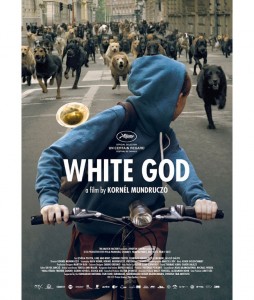 White God
White God
Director: Kornél Mundruczó
Starring: Zsófia Psotta, Sándor Zsótér, Lili Horváth, and Lili Monori
121 Minutes
Rated R
Opening at FilmBar
Dog is man’s best friend. They are loyal, obedient, with a love unbounded. These are sentiments that could describe the furry canine friend sitting at your feet while you are reading this review. In Hungarian director Kornél Mundruczó’s film “White God” they are spot-on feelings for the first half of the film. The enduring trust and love between a young girl named Lili and her dog Hagen display the interactions that dog lovers know well. However, once the two are separated and Hagen is left to his own survival on the mean streets, the corruption and hate that fills the world in “White God” consumes Hagen and forces retaliation. The film is very much about the imposing and superior approach that humans have over animals, specifically in matters of mistreatment. Mundruczó mixes genres to make “White God” come to stunning life, finishing the film with one of the most impressive animal spectacles of recent memory.
Lili and Hagen are inseparable. Companions that support each other in ways each will never completely understand. Lili is living with her father for a short time. A state official informs Lili’s father that there is a hefty tax for dogs that aren’t purebred. Not wanting to pay the tax Lili’s father abandons Hagen in the middle of the street in the city. Hagen, proven faithful, is trusting to all the wrong people. However, in this city, it seems that most humans are the wrong kind of people. Hagen is abused, forced into dogfighting by a cruel master. Hagen escapes but is caught and sent to the dog pound, though with a damaged temperament and serious wound, his fate is sealed. Faced with death, Hagen escapes with nothing more than retaliation on his mind.
The narrative involves a simple setup but there are other themes that peek through and offer some interesting points for thought. The commentary about the mistreatment of mixed bred dogs and the correlation to the rising frustrations and injustices scene in society is the strongest point. It’s a story about power and how it has been utilized to abuse and restrain. It’s also a story about the taking of power and the choices associated with how this responsibility should be utilized. Yes, this is a story about a dog, but it is obvious that the writer was striving for larger perspectives.
The film transitions with an unexpected turn, changing “White God” from a dramatic film into a horror film. It’s a daring twist but the director clearly understands how genre functions, implementing characterized traits like stalking perspectives and dark figures moving in the shadows to establish the atmosphere. What strongly assists this change is the fact that the director utilized real dogs, two hundred plus trained dogs that sprint through the streets, jump over obstacles, and make a formation that is similar to a army tactical stance. It’s stunning filmmaking that displays the creativity employed by the director. What is somewhat unfortunate is that this grand and bold event of animal uprising doesn’t take advantage of the event from a photography perspective. Many of the scenes are still composed with shaky camera work or a stationary “point and shot” style. This may in part be an unavoidable obstacle because of the amount of choreography needed for the trained animals during the scene. Regardless of this minor creative choice, the finale is enthralling, sad, and beautiful.
“White God” is a brutal film at times, one that could split animal lovers over the difficult scenes the dogs are placed in. The story is simplistic with a genre twist that changes it from a touching drama about a young girl and her dog into a brutal commentary about animal abuse and finally into a gory revenge filled horror film. It’s unlike any animal film you will likely see produced in America.
Monte’s Rating
4.00 out of 5.00









